|
'OUTCROP ANALOG' FIELD TRIPS
Vital economic importance
Using improper outcrop analogs for oil- and gasfield development in technologically difficult deep-water settings jeopardises billions of dollars in field commerciality or non-commerciality decisions (based on unreliable predictions of flow rates and reserves) and non-optimum placement of wells and perforations.
1. Turbidite Reservoir Analog Field Trips:
Bude Formation, Cornwall, UK
Introduction
'Flysch' is a term historically applied to any formation interpreted as deep-sea, syn-tectonic turbidites. It is now clear that ten renowned outcropping flysch formations (Annot, Brushy Canyon, Bude, Cerro Toro, Hecho, Jackfork, Laingsburg, Marnoso-arenacea, Ross, Skoorsteenberg) in peripheral foreland basins around the world are in fact shelfal, each deposited in a shelf-depth gulf (blind shelf) that passed along strike into a subducting remnant ocean and its passive margin …
download Higgs AAPG 2008 abstract (78KB)
download Higgs AAPG 2009 Discussion (5 pages, 810KB)
download Higgs IAS 2013 abstract (71KB)
download AAPG 2014 abstract (69KB)
weblink to Higgs AAPG 2014 article & poster (9.5MB)
Evidence for shelf depths includes abundant mud-draped scours (erosion by storm waves; including 'megaflutes') and frequent beds with combined-flow ripples and/or HCS (see examples in photos below). This foreland-basin 'external flysch' (supracontinental by definition; also called 'shelf flysch' or 'shallow flysch' by me) must not be confused with 'internal flysch' of the adjacent accretionary-prism mountains, comprising trench and ocean-floor strata (with 'flysch-type' deep-sea foram assemblages, available for fluvial suspension reworking into the external flysch) scraped off subducted ocean crust, and often (but not always) more structurally deformed than the external flysch. Shallow-flysch turbidites (Bouma- and Lowe-type) are interpretable as megaflood hyperpycnites, fed to the gulf via a gulf-head delta. The HCS beds, interpreted by some as internal-wave-modified turbidites, are reinterpreted here as surface-wave-modified hyperpycnites.
I have visited the Ross (2 weeks), Brushy (2 days), Skoorsteenberg (4 days) and, of course, the Bude Formation (> 200 days; I live on it!), and have demonstrated the evidence for waves in the Bude to many visiting world-renowned sedimentologists, often to their great surprise. The Ross, Brushy, Skoorsteenberg and Bude are almost indistinguishable in the field, all being relatively fine-grained.
Bude Formation: world’s best flysch outcrop for reservoir-analog studies?
The Upper Carboniferous Bude Formation is ideal for detailed reservoir-characterization studies, and offers the following advantages over the other nine named formations:
- more than 50 years of published sedimentological debate, since key paper by H.G. Reading, 1963, 'A sedimentological comparison of the Bude Sandstones with the Northam and Abbotsham Beds of Westward Ho!' Proceedings of the Ussher Society, v. 1, p. 67-69.
- magnificent 15 km cliffline with near-continuous exposure, plus intermittent wave-cut platforms (see photos below and on the 'Petroleum Sedimentology Course' and ‘Bude Geological Walks’ pages)
- exquisite sedimentological detail in wave-polished exposures
- 1.3 km stratigraphic thickness, with along-coast repetition by folding allowing proximal-distal comparisons within decametric intervals
- ability to trace individual beds for 10s m up the cliff by eye, and locally to walk beds out horizontally > 10 m revealing, for example, that "debrites" and "slumps" can in fact grade sideways into undeformed heterolith, proving their in situ origin, i.e. seismites
- superb structural geology (Variscan foreland-basin chevron folds and faults)
- London only 4 hours by road, Bristol airport 2.5, Exeter and Newquay airports 1.3
- free and mostly easy public access throughout, via spectacular South West Coast Path and (at low tide) sandy beach
- world-famous Cornish ambience (breathtaking scenery, maritime/mining history, hospitality, pasties, seafood, ale, etc.).
External flysch as outcrop analogs
The ten named external-flysch formations are excellent outcrops analogs (and 'self-analogs') for external-flysch reservoirs, e.g. oil- or gas-productive Brushy, Jackfork, Marnoso, Puchkirchen (Austria), Magdalena, Krosno (Poland). The ten are also valuable as partial analogues for many turbidite reservoirs, probably deposited in shallower water than is popularly believed, in sag basins and rift basins (elongated; high-relief provenance; longitudinal supply), e.g. North Sea & Falkland Basins rift and sag phases.
In stark contrast, external-flysch outcrops are highly unsuitable (though regrettably very popular) and misleading as analogs for truly deep-sea (0.5-5km), turbidite fan- and leveed-sinuous-channel reservoirs of passive margins (sic) (e.g. Brazil, West Africa, Gulf of Mexico) because:
- the tectonically active (versus passive margin) setting of external flysch means faster subsidence, susceptibility to earthquakes (e.g. injectites), and closer highlands (supply volume and calibre)
- foreland-basin confinement is 3-way (lateral, proximal), unlike passive-margin fans (1-way, hence susceptibility to Coriolis bending and contourites) and slope minibasins (4-way)
- storm-wave scour, absent in the deep sea, affects sand-body architecture (amalgamation, truncation)
- typical 'channels' in the shallow-flysch outcrops are incisional (interpretable as shelf-indenting submarine-canyon tributaries), minimally sinuous, and lacking proven levees, very different from passive-margin sinuous leveed channels. The presence or absence of levees has dramatic implications for sand-body geometry and composite architecture
- mass transport deposits are voluminous on continental slopes.
Thus, shelf-flysch outcrops are essential for showing us what passive-margin, deep-sea reservoirs do NOT look like. Unfortunately, thousands of petroleum geoscientists have been led to believe the contrary during industry field trips to classic outcrops like those of the Annot, Hecho, Marnoso, Ross and Skoorsteenberg.
Come to Bude and judge for yourselves - it's on your doorstep!
Contact
For reservoir-analog field trips to Bude, tailored for your own oil company or university, please email rogerhiggs@hotmail.com
 Bude Formation, Carboniferous (Westphalian), SW England. Note: '2.5-dimensional' exposure (cliff & discontinuous wave-cut platform); people on cliff top (cliff height 30m); typical external-flysch "packeting" of turbidites; no visible channels or canyons; syncline at right-hand side. Photo © Roger Higgs. Bude Formation, Carboniferous (Westphalian), SW England. Note: '2.5-dimensional' exposure (cliff & discontinuous wave-cut platform); people on cliff top (cliff height 30m); typical external-flysch "packeting" of turbidites; no visible channels or canyons; syncline at right-hand side. Photo © Roger Higgs.
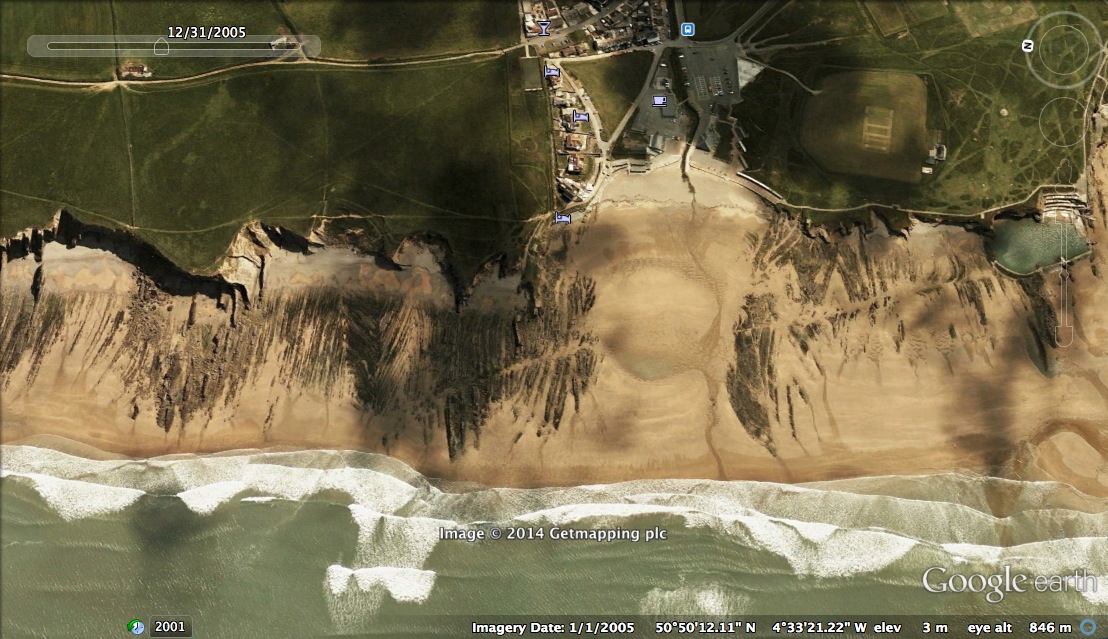 Google Earth (2005) view of Crooklets Beach and vicinity, Bude. For scale, bar at top left is 250m. Bude Sea Pool is at far right (south); also cricket ground. Dark shadows are due to clouds. Bude Fm turbidites are superbly exposed in the cliff and wave-cut platform (WCP), i.e. in '2.5D'. Chevron folds plunging gently west appear as 'V' patterns on the WCP (i.e. in horizontal section), cut by a prominent sinistral wrench fault trending NW from Sea Pool. Note large cliff exposures of sub-vertical bedding planes, toward left (north). Google Earth (2005) view of Crooklets Beach and vicinity, Bude. For scale, bar at top left is 250m. Bude Sea Pool is at far right (south); also cricket ground. Dark shadows are due to clouds. Bude Fm turbidites are superbly exposed in the cliff and wave-cut platform (WCP), i.e. in '2.5D'. Chevron folds plunging gently west appear as 'V' patterns on the WCP (i.e. in horizontal section), cut by a prominent sinistral wrench fault trending NW from Sea Pool. Note large cliff exposures of sub-vertical bedding planes, toward left (north).
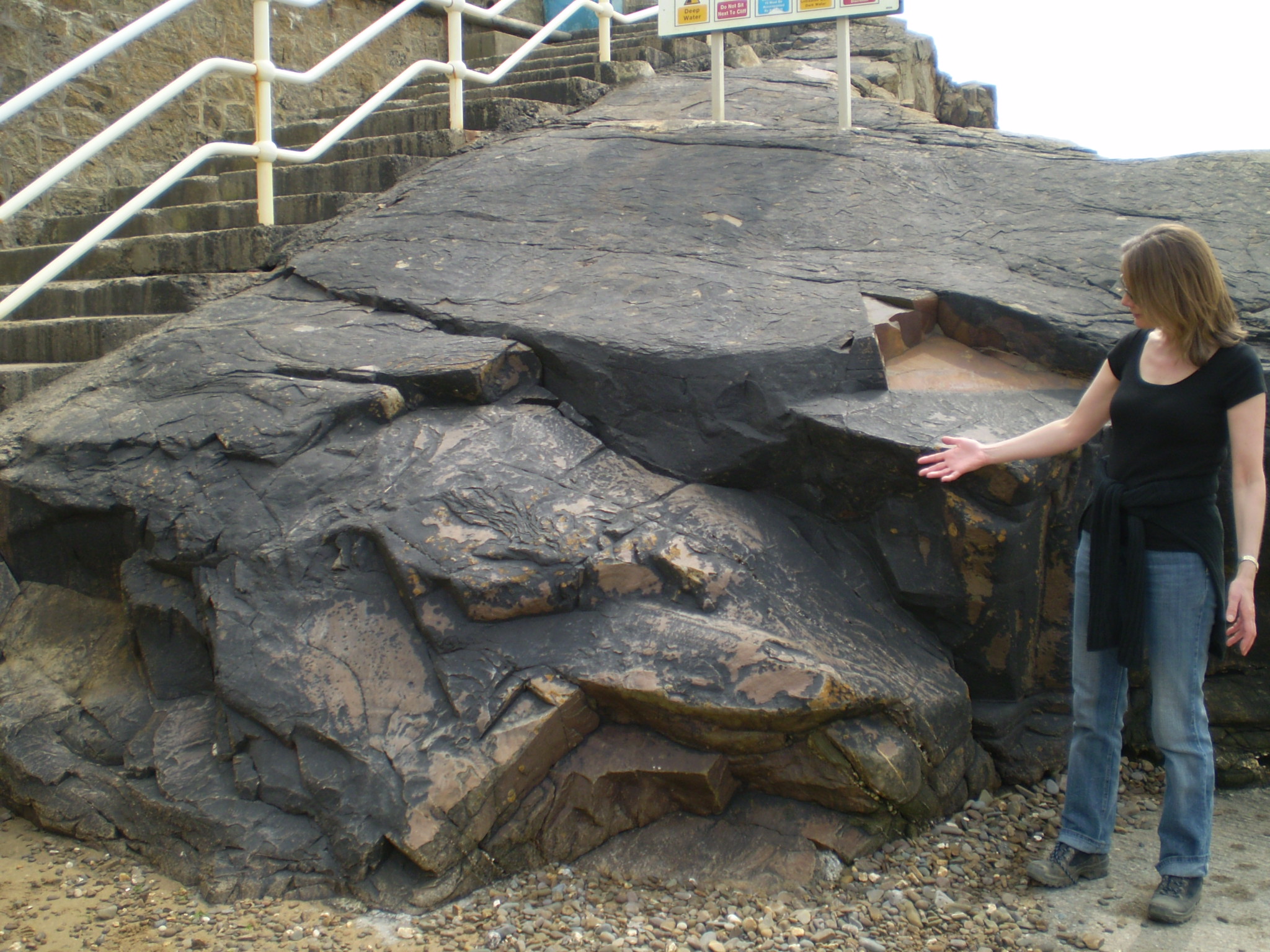 Bude Fm hummocky cross-stratified fine-grained sandstone coated with black lichen at Bude Sea Pool. Hummocky upper surface of this amalgamated sandstone unit dips toward viewer, sub-parallel to stairway. Photo © Roger Higgs. Bude Fm hummocky cross-stratified fine-grained sandstone coated with black lichen at Bude Sea Pool. Hummocky upper surface of this amalgamated sandstone unit dips toward viewer, sub-parallel to stairway. Photo © Roger Higgs.
 Bude Fm HCS. Close-up of centre-left of previous photo. Upper half best shows the undulating lamination. Lower half shows several fracture traces, trending toward lower right, intersecting the bedding. Photo © Roger Higgs. Bude Fm HCS. Close-up of centre-left of previous photo. Upper half best shows the undulating lamination. Lower half shows several fracture traces, trending toward lower right, intersecting the bedding. Photo © Roger Higgs.
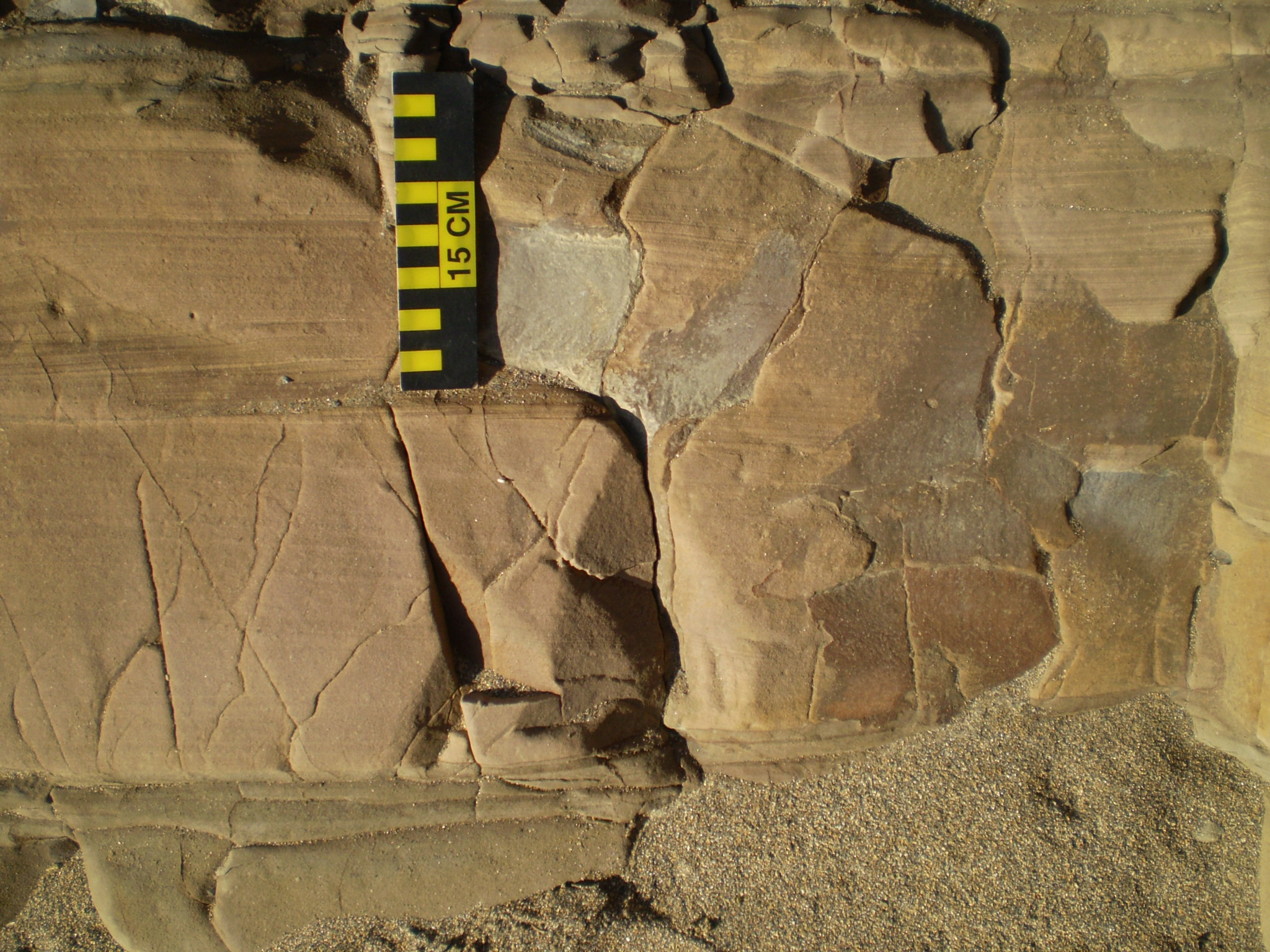 Bude Fm HCS at Widemouth Bay. Photo © Roger Higgs. Bude Fm HCS at Widemouth Bay. Photo © Roger Higgs.
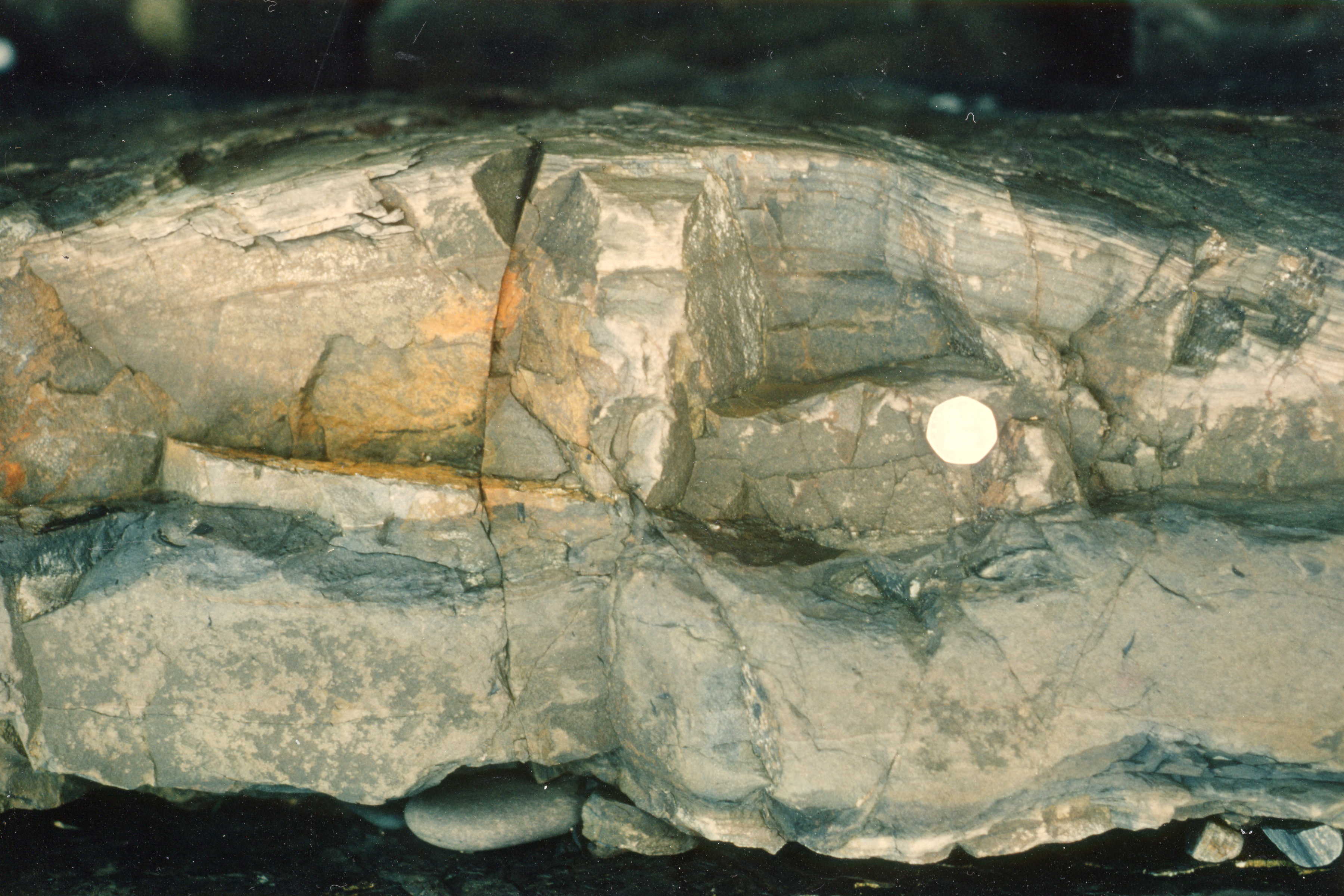 Bude Fm hummock and HCS at Upton. Coin 3cm across. Photo © Roger Higgs. Bude Fm hummock and HCS at Upton. Coin 3cm across. Photo © Roger Higgs.
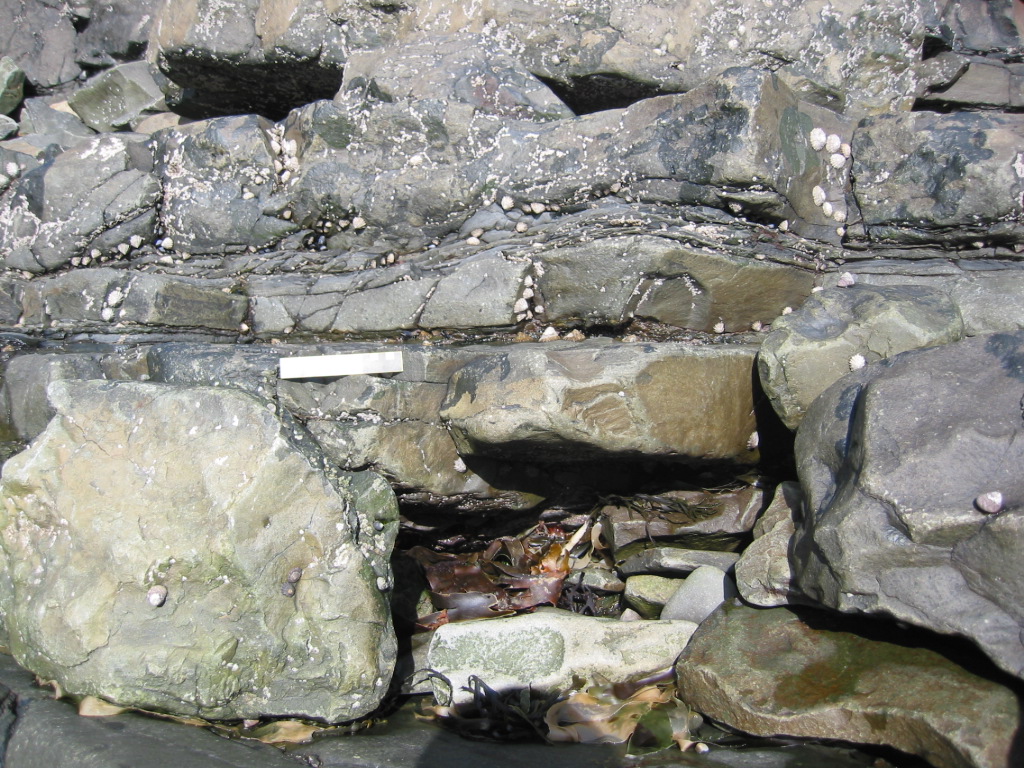 Hummocky bed (centre) in the Ross Fm, Carboniferous, Ireland. The sandstone bed below (largely covered by loose beach boulders), on which the 15cm scale is lying, shows faint HCS, undetectable in this photo. HCS in flysch is commonly blurred by inferred earthquake liquefaction. Photo © Roger Higgs. Hummocky bed (centre) in the Ross Fm, Carboniferous, Ireland. The sandstone bed below (largely covered by loose beach boulders), on which the 15cm scale is lying, shows faint HCS, undetectable in this photo. HCS in flysch is commonly blurred by inferred earthquake liquefaction. Photo © Roger Higgs.
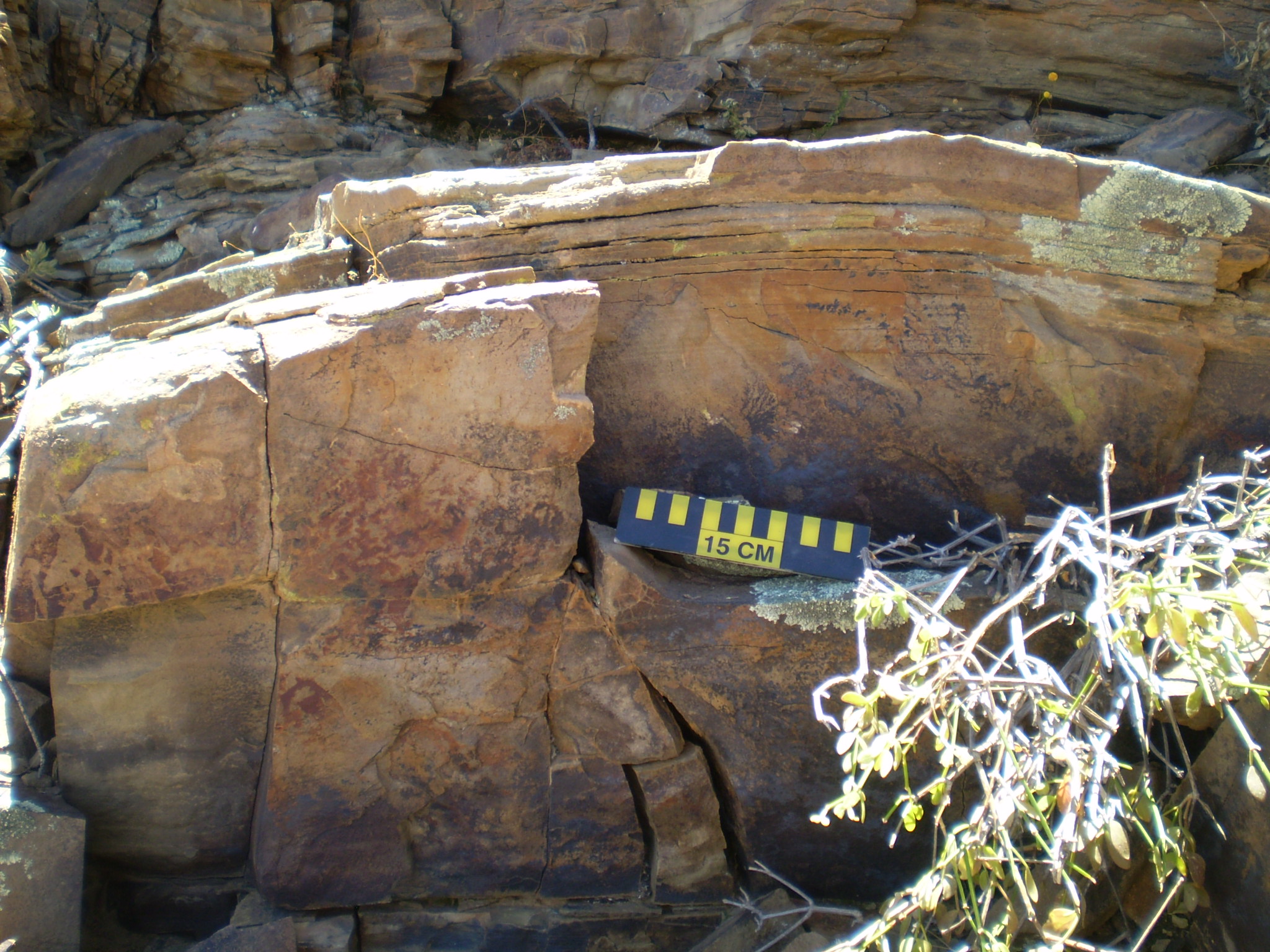 Skoorsteenberg Fm, Permian, South Africa. Decimetric bed of fine- or very-fine sandstone, with flat base visible near bottom of photo, and convex-up top (overlain by recessive shale). Faint horizontal lamination in the lower portion, possibly blurred by rapid sediment fallout, is overlain (truncated?) by a form-concordant set of convex-up laminae. This structure is reasonably interpreted as HCS. Photo © Roger Higgs. Skoorsteenberg Fm, Permian, South Africa. Decimetric bed of fine- or very-fine sandstone, with flat base visible near bottom of photo, and convex-up top (overlain by recessive shale). Faint horizontal lamination in the lower portion, possibly blurred by rapid sediment fallout, is overlain (truncated?) by a form-concordant set of convex-up laminae. This structure is reasonably interpreted as HCS. Photo © Roger Higgs.
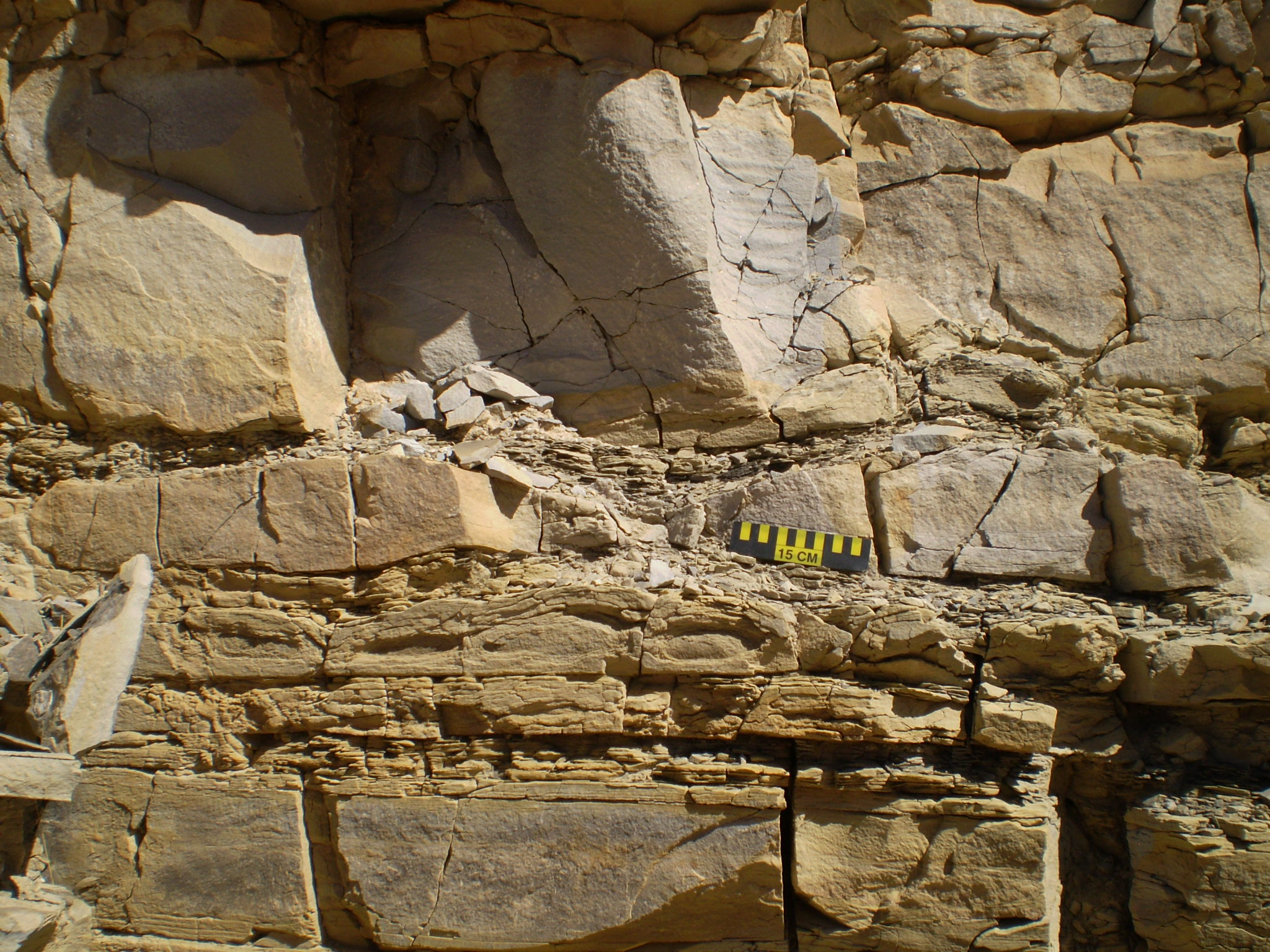 Brushy Canyon Fm, Permian, Texas, USA. Hummocky bed (centre) with indistinct internal lamination. Note blurred low-angle lamination in the bed above. Photo © Roger Higgs. Brushy Canyon Fm, Permian, Texas, USA. Hummocky bed (centre) with indistinct internal lamination. Note blurred low-angle lamination in the bed above. Photo © Roger Higgs.
 Brushy Canyon Fm probable HCS, blurred by inferred earthquake liquefaction. Note 15cm scale in recess near top centre. Photo © Roger Higgs. Brushy Canyon Fm probable HCS, blurred by inferred earthquake liquefaction. Note 15cm scale in recess near top centre. Photo © Roger Higgs.
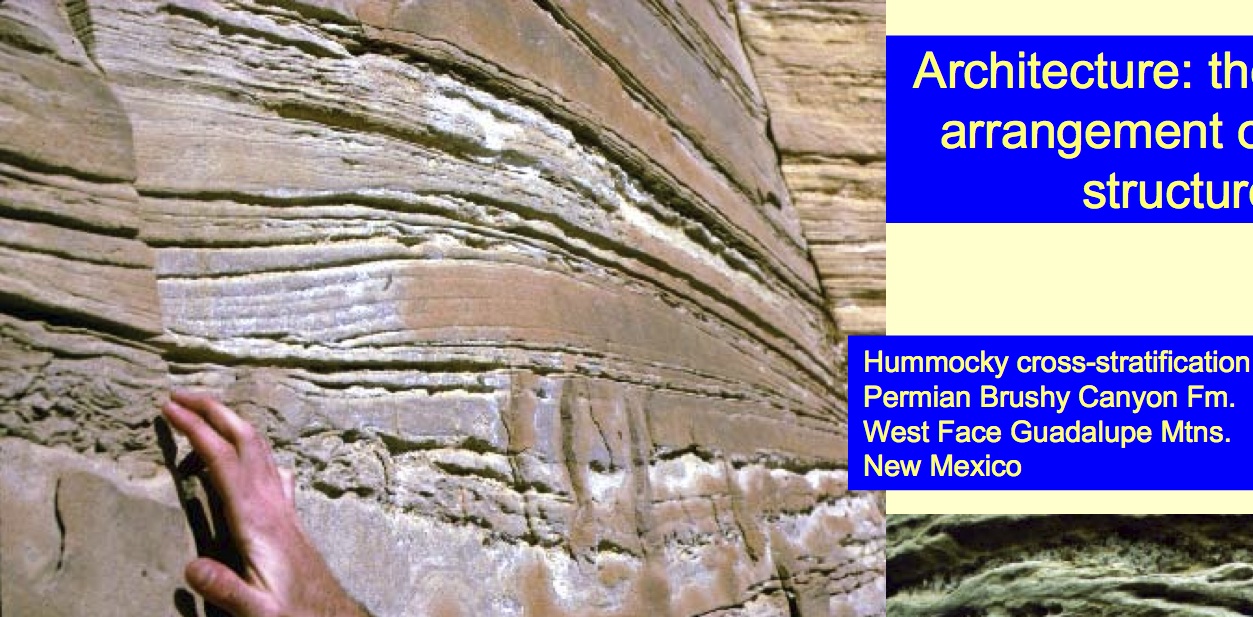 Brushy Canyon Fm HCS. From university course lecture notes by Dr Marc S. Hendrix (downloaded 2007). Brushy Canyon Fm HCS. From university course lecture notes by Dr Marc S. Hendrix (downloaded 2007).
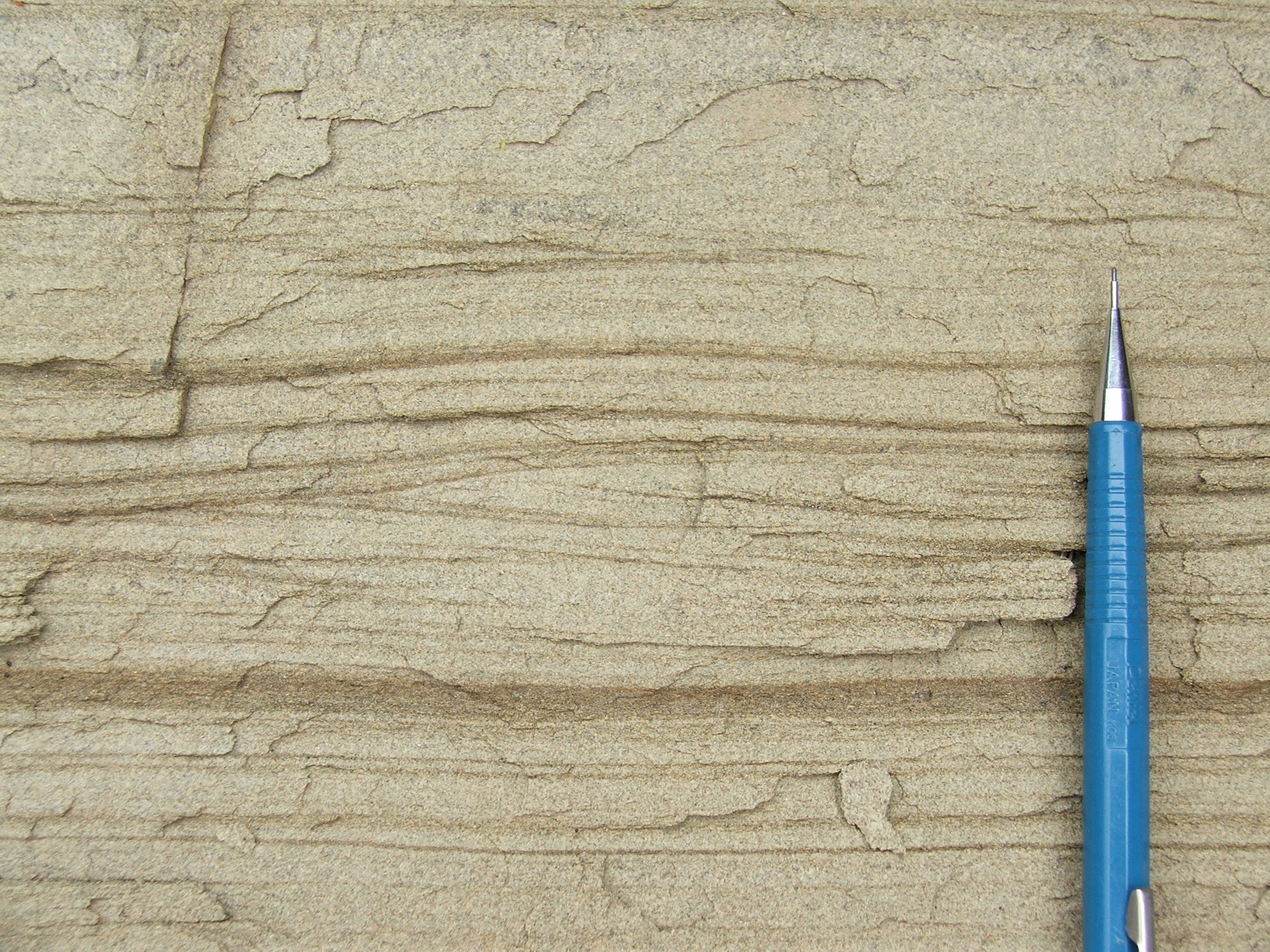 Probable HCS, Annot Fm, Eocene-Oligocene, France. Photo by Dr B.W. Romans. From http://clasticdetritus.com/2009/05/15/friday-field-foto-84-plane-and-ripple-laminated-sandstones-in-france/ Probable HCS, Annot Fm, Eocene-Oligocene, France. Photo by Dr B.W. Romans. From http://clasticdetritus.com/2009/05/15/friday-field-foto-84-plane-and-ripple-laminated-sandstones-in-france/
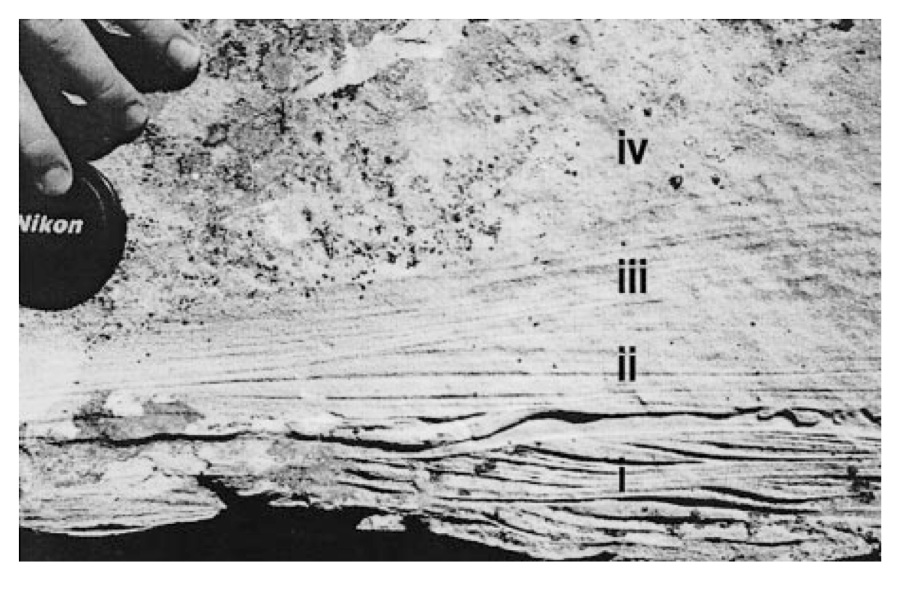 Probable HCS, Marnoso-arenacea Fm, Miocene, Italy. From Kneller & McCaffrey 2003, Journal of Sedimentary Research, v.73, p.706–713. Probable HCS, Marnoso-arenacea Fm, Miocene, Italy. From Kneller & McCaffrey 2003, Journal of Sedimentary Research, v.73, p.706–713.
2. Deltaic & Turbidite Reservoir-Characterization Field Trips:
Bideford & Bude Formations, SW England
On this field trip, tailored to clients’ requirements, we examine the external and internal characteristics of composite sandstone bodies ("architectural elements") in two Carboniferous formations, the Bideford and Bude, magnificently exposed in the coastal cliffs of north Cornwall and north Devon, a beautiful region with a long history of geological research, dating back to the naming of the Devonian period by Murchison and Sedgwick in 1839. Although both formations comprise sandstones and shales, and are partially contemporaneous, the two facies associations are distinctly different, interpreted in the literature as Bideford deltaics interfingering southward with Bude offshore turbidites. Thus, sand bodies at the two locations differ fundamentally, with implications for predicting production behaviour and reserves in analogous oil and gas reservoirs.
For reservoir characterization field trips to Bideford and Bude, please email rogerhiggs@hotmail.com
|